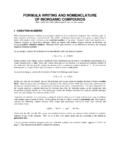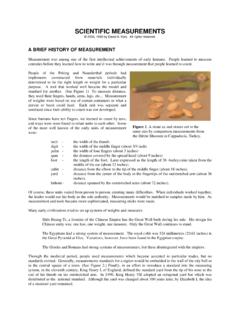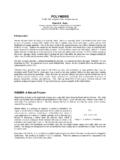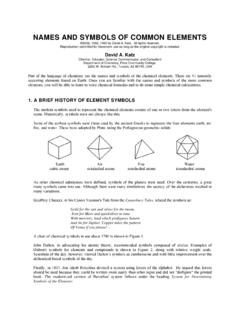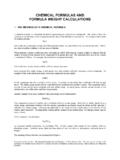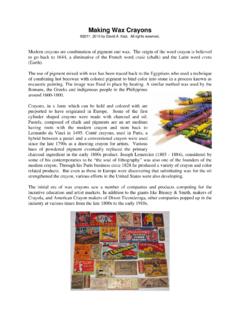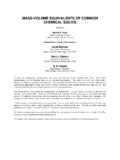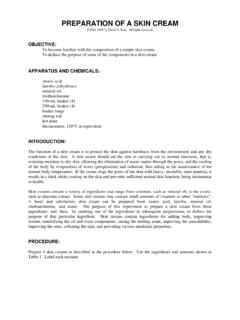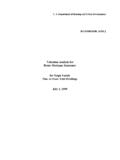Transcription of HAIR ANALYSIS - chymist.com
1 Hair ANALYSIS 2005, 2004, 2003, 2001, 1999 by David A. Katz. All rights reserved. Hair can be important physical evidence at a crime scene. Hair normally falls from the body over the course of a day. It will stick to a number of materials, especially fabric and clothing. Hair is not easily destroyed, even with exposure to moisture and decomposition of accompanying tissue. There are three types of hair usually seen in animals: Vibrissa. These are the whiskers of many animals. They are normally tactile and sensitive, such as the whiskers on a cat. Bristle.
2 This is the coarse bristle that provides an animal with a protective coat. These guard hairs can readily be identified by their distinctive appearance and morphology between various animal families. Wool. Wool or fur provides insulation from wet and cold. These fine hairs cover the bodies of all mammals. Head and body hair of humans is classified as intermediate hair combining the characteristics of bristle and wool hairs. Four types of hair appear on the bodies of humans: Primordial hairs appear as early as the 3rd month of gestation, growing on the upper lip, the eyebrows, the palms and soles of the fetus.
3 They gradually disappear and are replaced by softer lanugo hair over the entire body. Lanugo hairs are normally shed after the 6th month of gestation. They are fine, soft, unmedullated, and normally unpigmented hairs. The surface of lanugo hair is smooth with almost indiscriminate scales. It is replaced by vellus and terminal hairs. Lanugo hair is often observed on an aborted fetus and can be useful in investigation of possible infanticide. Vellus hairs are the fine, soft, unmedullated hairs spread uniformly over the the body surface.
4 They rarely are more than 2 cm in length. Terminal hair is found on the scalp, eyebrows, eyelashes, and, to a lesser extent, the limbs of both sexes. Puberty is accompanies by pubic and axillary hair growth such as hair of the face, chest, back, arms, and legs. The various terminal hair types can be distinguished by density and morphology. Hair is an appendage of the skin that grows out of an organ known as the hail follicle. (See figure H-1) The root is the portion that lies in the follicle, and the portion above the skin surface is the shaft.
5 The base of the root is called the bulb. Hair is composed of a group of proteins (keratins) that interconnect to form stable fibrils. Keratin protein chains are very complex both histologically and chemically due to the multiplicity of the cross-linked protein molecules. One of the more important linkages between adjacent keratin chains is the disulfide bond (-S-S-) that makes the keratin extremely resistant to biological and chemical degradation. It is through breaking and reforming of the disulfide bonds that hair can be reshaped through a permanent.
6 Also, toxins, expelled from the body, can be found in the hair. A hair shaft consists of a translucent outer layer called the cuticle. It consist of overlapping, nonnucleated, pigment- free cells that form scales. (See Figure H-2 and Figure H-3). These scales are composed of specialized cells that have hardened (keratinized). The free ends of the scales point away from the root toward the distal end of the hair shaft. The cuticle structure is different for each type of hair from different animals. The distal margins for human hair normally do not protrude, leaving the outer margin flat.
7 Animal hair, such as cat or rabbit are highly serrated and interlocking. Hair cuticle can be damaged leaving cracked, ragged, or flattened outer or inner cuticular margins. (See Figure H-4)_ The cortex is composed of elongated, fusiform, keratinized filaments aligned parallel to the length of the hair. Variable amounts of air spaces called cortical fusi are interspersed among the cortex. Initially, the fusi are filled with fluid, but later become filled with air as the hair dries out. Hair color, although influenced by cortical fusi, the medulla, and cuticular surface is primarily due to the amount of pigment in the cortex.
8 The coloring is due to pigment granules (melanin) interspersed throughout the cortex. Microscopically, hairs show only black, brown, and yellow pigment granules. True blond and red hair color pigments are called phaeomelanin. The size and shape of the pigment granules, as well as their density and distribution along the shaft, will differ from individual to individual. Hairs exhibit a cellular column running through the center of the cortex called the medulla. (See Figure H-5) The presence of this feature varies from individual to individual and between hairs of a given individual.
9 In humans, the medulla appears dark under transmitted light because it is filled with air. If filled with fluid, the medulla may take on a yellowish color. If not visible under normal microscopic examination, the medulla may be more easily observed between crossed polar of a polarizing microscope. Figure H-1: Cross section of the skin showing hair follicles. Reference: Reproduced from Saferstein, Criminalistics, 5th Ed., Prentice Hall, 1995. Figure H-2. Cross section of a hair shaft. Reference: Bisbing, Richard E., in Saferstein, Editor, Forensic Science Handbook, Vol.
10 1, 2nd Ed., Prentice Hall, 2002. Figure H-3: Scale or cuticle patterns of several different kinds of hair. (a) Human head hair (600x), (b) dog fur (1250x), (c) Deer hair (120x), (d) Rabbit fur (300x), (e) Cat fur (2000x), (f) Horse hair (450x). Reproduced from Saferstein, Criminalistics, 5th Ed., Prentice Hall, 1995 Figure H-4. Cuticular margins of human hair. Reference: Bisbing, Richard E., in Saferstein, Editor, Forensic Science Handbook, Vol. 1, 2nd Ed., Prentice Hall, 2002. The medulla patterns of animals may be broad, occupying more than half of the shaft diameter.


